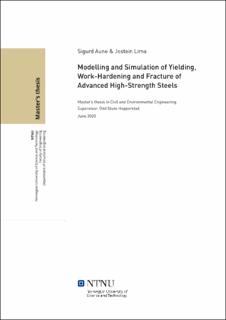| dc.contributor.advisor | Hopperstad, Odd Sture | |
| dc.contributor.advisor | Dæhli, Lars Edvard Blystad | |
| dc.contributor.advisor | Martin, Maria Jesus Perez | |
| dc.contributor.advisor | Erice, Borja | |
| dc.contributor.author | Aune, Sigurd | |
| dc.contributor.author | Lima, Jostein | |
| dc.date.accessioned | 2021-09-21T16:13:54Z | |
| dc.date.available | 2021-09-21T16:13:54Z | |
| dc.date.issued | 2020 | |
| dc.identifier | no.ntnu:inspera:56511028:23369818 | |
| dc.identifier.uri | https://hdl.handle.net/11250/2780032 | |
| dc.description.abstract | I denne avhandlingen ble eksperiment med syklisk last utført ved bruk av et anti-knekkingsutstyr for å undersøke hvilken påvirkning volumfraksjonen av martensitt har på Bauschingereffekten i tofasestål. Fire forskjellige tofasestål ble undersøkt: Docol 500DP, 600DP, 800DP og 1000DP. Deretter ble modellering og simulering basert på mikrostruktur utført for å undersøke hvilken påvirkning volumfraksjonen og fordelingen av martensitt har på flyt, fastning og duktilitet i tofasestålene. Til slutt ble det foreslått materialmodeller som kan brukes i storskalasimuleringer basert på eksperimentelle data og mikromekaniske analyser.
Syklisk last eksperimentene hvor anti-knekkingsutstyret ble brukt var vellykket, og det ble funnet at Bauschingereffekten økte med stålkvaliteten og volumfraksjonen av martensitt.
Modelleringen basert på mikrostruktur ble gjennomført ved å danne et rammeverk for modellering av plastisitet og brudd. Fire forskjellige representative volumelementer (RVEer) med idealisert geometri ble vurdert. RVEen med én kubisk øy av martensitt la grunnlaget for rammeverket, ettersom dette var RVEen som etterlignet spennig-tøyningskurvene fra eksperiment best.
RVEene ble brukt for å undersøke flyt, fastning og duktilt brudd. Det ble funnet at flytningen liknet en Hershey flyteflate med eksponenten m=6. Videre ble det funnet at styrkeforskjellen mellom ferritt og martensitt ikke var nok til å gjenskape hele Bauschingereffekten observert i eksperimentene. Bruddstudiet ble utført ved å implementere Gursonmodellen inn i materialmodellen til ferritten. Effektene av Gurson-parameterne og bruddmekanismene ble deretter undersøkt. Det ble konkludert at Gursonmodellen med kun initiale porer og et porøst bruddkriterium ikke var godt nok når volumfraksjonen av martensitt økte.
Til slutt ble det, basert på eksperimenter og idealiserte RVEer, foreslått materialmodeller som kan brukes i storskalasimuleringer. Dette ble gjort med en mikro-til-makrometode. De resulterende materialmodellene var Gursonmodeller hvor Voce fastningslov og skade gjennom nukleering og vekst av porer ble inkludert. | |
| dc.description.abstract | In this thesis, cyclic load experiments are conducted by use of an anti-buckling device to investigate the influence of martensite volume fraction on the Bauschinger effect in dual-phase (DP) steels. Four different DP steels are tested: Docol 500DP, 600DP, 800DP and 1000DP. Then, microstructure-based modelling and simulations are conducted to study the influence of martensite volume fraction and distribution on yielding, work-hardening and ductility of the DP steels. Finally, material models for the DP steels applicable to large-scale FE simulations based on the experimental data and the micromechanical analyses are proposed.
The cyclic load experiments were successfully conducted by use of an anti-buckling device. The Bauschinger effect was found to increase with the DP steel quality and the martensite volume fraction in the experiments.
The microstructure-based modelling was done by establishing a micromechanical FE modelling framework for plasticity and fracture. Four different representative volume elements (RVEs) with idealized geometry were considered. An RVE with a single cubical martensite island in the centre was established as the micromechanical FE modelling framework since it in general was superior to the other three when compared to stress-strain curves from experimental data.
The RVEs were used to perform a numerical study on yielding, work-hardening and ductile fracture. It was found that the yielding resembled the Hershey yield locus with an exponent of m=6. Further, it was reported that the ferrite-martensite strength difference did not capture all of the Bauschinger effect experienced in experiments. The numerical study of ductile fracture was based on the implementation of the Gurson model in the ferrite material model. The influence of the Gurson parameters and the obtained fracture mechanisms were discussed. It was concluded that the Gurson model with only the initial void volume fraction feature and the porous failure criterion was not sufficient when the martensite volume fraction increased.
Lastly, material models were proposed for DP steels applicable to large-scale FE simulations based on experiments and idealized RVEs. This was done by conducting a micro-macro transition approach. The final material models were Gurson models, where the work-hardening was described by Voce hardening laws and damage was included through nucleation and growth of voids. | |
| dc.language | | |
| dc.publisher | NTNU | |
| dc.title | Modelling and Simulation of Yielding, Work-Hardening and Fracture of Advanced High-Strength Steels | |
| dc.type | Master thesis | |
